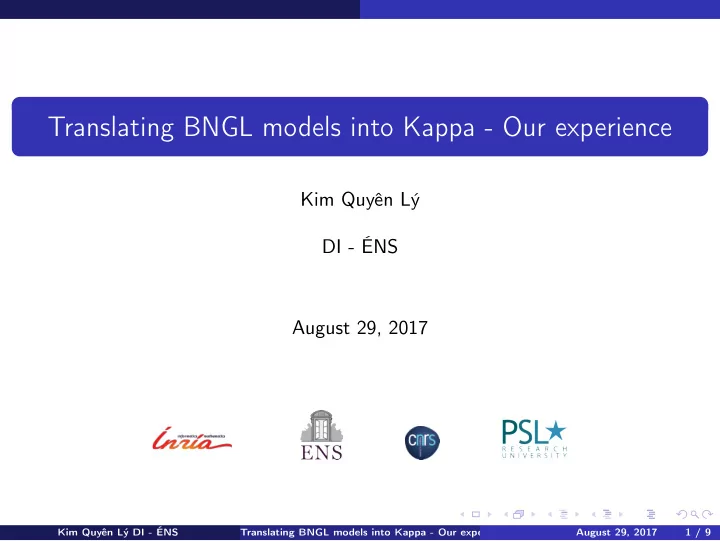

Translating BNGL models into Kappa - Our experience Kim Quyên Lý DI - ÉNS August 29, 2017 Kim Quyên Lý DI - ÉNS Translating BNGL models into Kappa - Our experience August 29, 2017 1 / 9
Outline Introduction 1 Equivalent sites 2 Conclusion 3 Kim Quyên Lý DI - ÉNS Translating BNGL models into Kappa - Our experience August 29, 2017 2 / 9
Introduction Introduction Kappa and BNGL are rule-based languages. Large systems of mechanistic interactions between proteins can be described and assembled. In order to test and evaluate the performance and the accuracy of the Kappa frameworks, we decided to translate the models that are provided with the BNGL distribution into Kappa. Kim Quyên Lý DI - ÉNS Translating BNGL models into Kappa - Our experience August 29, 2017 3 / 9
Introduction Introduction We have validated our translation by the following two steps procedure: We use static analyser KaSa to check the consistence of the models. KaSa can quickly inspect all the potential applications of the rule in a model in order to synthesise constraints about the states of sites, detect dead rules, and separating transitions. We compile both versions of the models into reaction networks, obtain two systems of ODEs based on the same set of variables. We correct the models until getting the same trajectories. For the biggest models, we have validated the models block-wise (by adjusting the initial state, so as to make each rule applicable). Kim Quyên Lý DI - ÉNS Translating BNGL models into Kappa - Our experience August 29, 2017 4 / 9
Equivalent sites Equivalent sites With equivalent sites, we would model this by the following rule: A ( x u , l u ) → A ( x p , l u ) k With identified sites, we would consider 2 sites names: ′ case 1 ′ A ( x u , l ′ u ) → A ( x p , l ′ u ) @ k ′ case 2 ′ A ( x u , l ′′ u ) → A ( x p , l ′′ u ) @ k Kim Quyên Lý DI - ÉNS Translating BNGL models into Kappa - Our experience August 29, 2017 5 / 9
Equivalent sites Equivalent sites In Kappa: In BNGL: x x A A l” l’ l l Rates of reactions: Rates of reactions: l ′ \ l ′′ u p l \ l u p 2 k u k u k k 0 p k 0 p k A ( x u , l ′ u ) → A ( x p , l ′ u ) @ k A ( x u , l u ) → A ( x p , l u ) k A ( x u , l ′′ u ) → A ( x p , l ′′ u ) @ k Kim Quyên Lý DI - ÉNS Translating BNGL models into Kappa - Our experience August 29, 2017 6 / 9
Equivalent sites Equivalent sites In Kappa: In BNGL: x x A A l” l’ l l Correct encoding in Kappa: BNGL rule: ′ case 1 ′ A ( x u , l ′ u , l ′′ u ) → A ( x p , l ′ u , l ′′ u ) @ k A ( x u , l u ) → A ( x p , l u ) k ′ case 2 ′ A ( x u , l ′ u , l ′′ p ) → A ( x p , l ′ u , l ′′ p ) @ k ′ case 3 ′ A ( x u , l ′ p , l ′′ u ) → A ( x p , l ′ p , l ′′ u ) @ k Kim Quyên Lý DI - ÉNS Translating BNGL models into Kappa - Our experience August 29, 2017 7 / 9
Equivalent sites General solution In each agent, gather isomorphic occurences of equivalent sites. 1 isomorphic equivalent site = 1 contextual property. A Kappa instance map each identified site to the subset of the contextual properties it satisfies. Each rule is obtained by taking into account the properties that shall be satisfied and the ones that shall be violated. When they are compatible, these positive/negative conditions induce a refinement of the rule. Kim Quyên Lý DI - ÉNS Translating BNGL models into Kappa - Our experience August 29, 2017 8 / 9
Conclusion Conclusion Static analysis is required to check the consistency of models. We have discovered bugs in models published in the literature. Full pathways may be ignored unintentionally. Automatic translation of BNGL models into Kappa is possible, but it is not easy. Dealing with equivalent sites is not so easy. We have to be careful to avoid over-counting constant rates. We proposed a systematic way to do this. It requires a primitive to complement patterns. This can be automatized. http://dev.executableknowledge.org https://github.com/Kappa-Dev/KaSim Kim Quyên Lý DI - ÉNS Translating BNGL models into Kappa - Our experience August 29, 2017 9 / 9
Conclusion Implementing models for non local invariants. Implementing a domain to reason on sets of embeddings. Featuring computation (negation) and canonic form. Model reduction. We will integrate the workds on information flow in KaDe. Go beyond exact models, and design numerically approximated ones, that proposes equations for lower and upper bound of each variable of interest. Kim Quyên Lý DI - ÉNS Translating BNGL models into Kappa - Our experience August 29, 2017 10 / 9
Recommend
More recommend